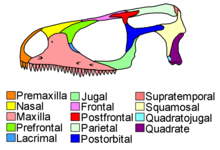Sophineta
| Sophineta Temporal range:Early Triassic,
| |
|---|---|

| |
| Cranial diagram | |
| Scientific classification | |
| Domain: | Eukaryota |
| Kingdom: | Animalia |
| Phylum: | Chordata |
| Class: | Reptilia |
| Clade: | Lepidosauromorpha |
| Genus: | †Sophineta Evans& Borsuk−Białynicka,2009 |
| Type species | |
| †Sophineta cracoviensis Evans & Borsuk−Białynicka, 2009
| |
Sophinetais anextinctgenusofbasallepidosauromorphreptileknown from theEarly Triassic(lateOlenekianage) ofMałopolska Province,southernPoland.It contains a single species,Sophineta cracoviensis.[1]
Discovery
[edit]Sophinetawas first described and named bySusan E. EvansandMagdalena Borsuk−Białynickain2009,and thetype speciesisSophineta cracoviensis.It is known fromholotypeZPAL RV/175, a nearly complete rightmaxilla.Many isolated or associated skull and postcranial fragments are referred to the species, representing frontals, parietals, prefrontal, postfrontals, postorbitals, jugals, squamosals, pterygoids, quadrates, maxillae, premaxilla, dentaries, vertebrae and ilia.[1]
Sophinetafossils were discoveredin situand collected in 1982 by a team (Paszkowski and Wieczorek) from theInstitute of Geological Sciences of Jagiellonian UniversityinKraków.They were collected from the Czatkowice 1 locality, a single exposure near Kraków from which a diverse fauna of small vertebrates is known. It represents Triassic karst deposits which developed in Early Carboniferous (Tournaisian to Mid Visean) limestone which is now mined at theCzatkowice quarry.The locality dates to the earliest LateOlenekianstage of theEarly Triassicperiod,about 247.3million years ago.Sophinetais the smaller of the two lepidosauromorph reptiles known from the Czatkowice quarry, alongside the larger kuehneosauridPamelina.Czatkowice 1 material was transferred to and stored at the Museum of the Earth and Institute of Paleobiology of thePolish Academy of SciencesinWarsaw.Preliminary chemical preparation inacetic acidwas initially performed, before effective preparation started in the 1990s until 2007.[1]
Etymology
[edit]Thegeneric namehonors ProfessorZofia Kielan-Jaworowskaof the Instytut Paleobiologii PAN, and it is derived fromGreeksophia,meaning "wisdom" which is the classical root of the name Zofia. Thespecific nameis derived fromCracovia,theLatinname forKraków,the closest major Polish city to the Czatkowice 1 locality (the type locality ofSophineta). It is also honors researchers at the University of Kraków for their work at the locality.[1]
Description
[edit]
Sophinetadiffers from allkuehneosaursandMarmorettain having shortvertebraebearingnotochordpits while lackingtransverse processes.It also haspleurodontteeth, rather thansubthecodontteeth like in all kuehneosaurs. Other differences are the presence of paired rather than confluent nares, the presence of weakly developed zygosphenoidal articulations on the vertebrae, and compressed keeled tooth tips rather than simple cones. It differs from thePaliguanain having a deeper facial process on themaxillaand a much smaller lacrimal, and fromMarmorettain that the latter has a specialised maxillary/premaxillaryoverlap.Sophinetaresembleslepidosaursin having weak zygosphenes, short vertebrae and single−headedribsthroughout the column, but differs in having a shallower pleurodont tooth implantation and the apparent absence of both athyroid fenestraand functional caudal autotomy.Sophinetahad an unspecialised vertebral column but fairly derived skull structure, including the tall facial process of the maxilla, reduced lacrimal and pleurodonty. These traits also resemble those of earlylepidosaursmore than stem−lepidosaurs. TheskullofSophinetareconstructed as a "modified diapsid skull" with a relatively short preorbital region. The orbits, narial openings and uppertemporal fenestraeare large, and the lower temporal fenestrae are open ventrally. Based on the dimensions of the ZPAL RV/175 and skull proportions inMarmoretta,its total skull length is estimated to be about 10 mm (0.39 in), with a body length (excluding the tail) of about 30 mm (1.2 in).[1]
Classification
[edit]Susan E. Evans and Magdalena Borsuk−Białynicka (2009) performed aphylogeneticanalysis that recoveredSophinetaas the sister group ofLepidosauria.The inclusion ofSophinetadisplaced the relictualMiddle JurassicMarmorettaand gave the origin of Lepidosauria a much older age. Thecladogrambelow follows their results.[1]
